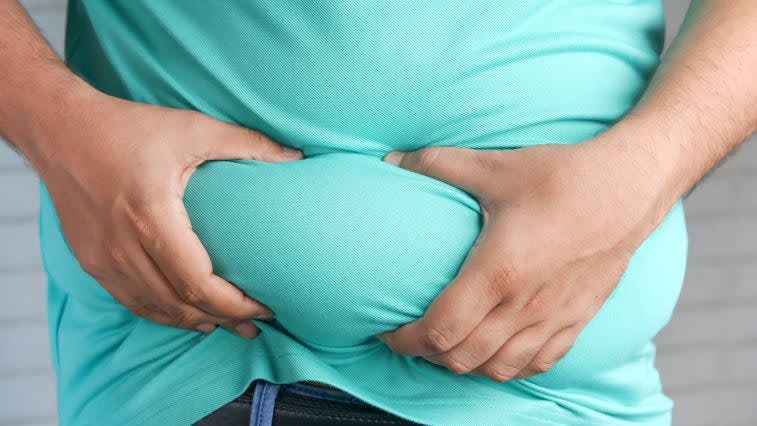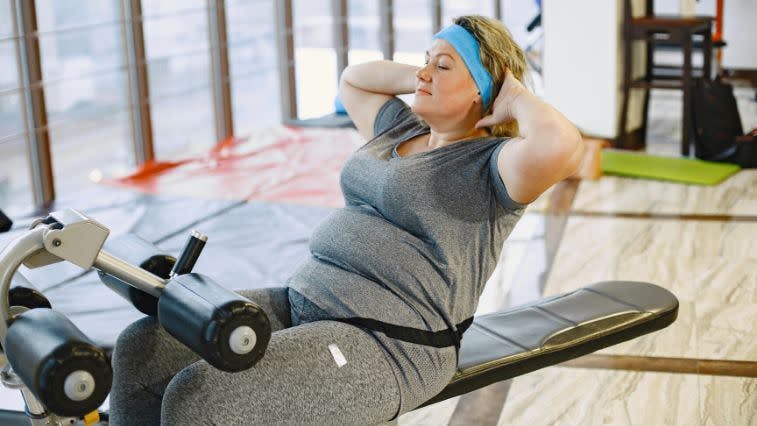How to Get Rid of Lower Belly Fat
Our content strives to support, inform, and motivate you to meet your health goals. We want to be your trusted source of expert- and science-backed info dispensed in simple, actionable ways. Read our Editorial Guidelines.
As we age or become more sedentary due to desk jobs and other life demands, belly fat can creep up on our waistlines. Some belly fat stores are normal and healthy, especially because fat pads our vital organs like the kidneys, liver, and intestines. But, as belly fat amounts increase, health risks such as developing type 2 diabetes and heart health issues also rise.
To decrease belly fat, people often want to target it directly with a single diet or exercise modification. Unfortunately, doing more abdominal work like Pilates or crunches, taking a specific dietary supplement, or eating one certain kind of food won't reduce your belly fat.
No fast fixes or shortcuts exist to burn or directly target belly fat.
As a registered dietitian, I share the key strategies I give my clients to decrease belly fat with time. Reducing your tummy requires an overall fitness, nutrition, and lifestyle approach. If you’d like to target your belly fat, these are my key tips for nutrition, exercise, and habits to try.
Basics of Belly Fat
The term “belly fat” indicates fat stores around the torso, including the abdomen and waist. In research studies, overall belly fat is typically measured using waist circumference (measured with a tape measure above the hips and circling around your whole waist) or with a waist-to-hip ratio.
Types of Belly Fat and Health Risks
Two types of fat make up belly fat: subcutaneous and visceral fat. Subcutaneous fat is more visible and found just underneath the layer of the skin on your belly and sides. It’s the soft fat you feel if you place your hands on your belly or squeeze extra tissue around the sides of your waist.
Visceral fat is deeper abdominal fat located around your organs and under your abdominal muscles. You can’t typically see or feel visceral fat stores.
In the Framingham Heart Study, which had 3,001 participants, increased belly fat was associated with increased health risks, such as:
Higher blood pressure
Increased fasting blood sugars and increased risk of type 2 diabetes
Increased risk of metabolic syndrome
Higher triglycerides
Decreased HDL, which is referred to as “good” cholesterol
Though subcutaneous fat may be uncomfortable for you or you might dislike the way it looks, higher levels of the deeper visceral fat are actually more dangerous to your health. In the Framingham study, visceral fat was strongly associated with more metabolic risk factors than subcutaneous fat. Interestingly, the association between visceral fat and health risk factors was stronger in women than in men.
Who Tends to Have More Belly Fat?

Men generally have more fat tissue in their abdomen, while premenopausal women store more fat in their lower bodies.
After menopause, women tend to have more abdominal fat, regardless of how much overall body fat they have. This is likely due to hormonal changes and decreasing amounts of estrogen.
As both men and women age, waist circumference and visceral fat tends to increase.
People who smoke cigarettes.
People who are more sedentary.
Nutrition Strategies to Get Rid of Belly Fat
To decrease belly fat, there are several nutrition strategies that you can try. The best research-backed approach points to a generally healthy diet and lifestyle that includes physical activity.
I advise my clients to eat whole foods, including good sources of protein (think chicken breast versus a highly processed hot dog), most grain choices from whole grains, plenty of fruits and vegetables, limited alcohol intake, and limited sugary foods and drinks.
A review of the scientific literature highlights the following nutrition recommendations:
Increase your protein intake: In a study of 617 Canadians of multiple ethnic backgrounds, “consuming more protein instead of carbohydrate was associated with less abdominal obesity independent of age, sex, BMI, height, smoking, physical activity, intakes of alcohol, total energy [intake], and ethnicity.”
The study’s authors advocate for decreasing intake of carbohydrates slightly and eating moderately higher protein intake. To achieve this, swap carb-rich snacks for higher protein ones. Instead of eating chips or pretzels in the afternoon, try Greek yogurt, cottage cheese with fruit, or two hard boiled eggs. You could also use the Plate Method at meal times, which would reinforce proper portion sizes for grain and starch foods.
Eat more whole grains: These types of grains contain all the components of an intact grain, meaning they include more fiber and nutrients than the highly refined versions. Examples include brown rice, quinoa, barley, oatmeal, and whole wheat bread.
In the Framingham Heart Study, eating more whole grains was associated with lower visceral belly fat, and higher intakes of refined grains was associated with more visceral fat. Adults who consumed three or more servings of whole grains per day had significantly lower subcutaneous and visceral belly fat. Visceral fat volume was 10% lower in people who consumed three or more servings of whole grains per day compared with those who consumed less than 0.2 servings.
Increase your soluble fiber intake: Soluble fiber is a type of fiber that mixes and at least partially dissolves with liquids during digestion. Good sources include oats, apples, peas, and beans, like chickpeas, black, and pinto beans.
In the IRAS Family Study, which included a large multiethnic population, the rate of visceral belly fat decreased by 3.7% for each 10-gram increase in soluble fiber a person ate. Overall fiber intake was also an important factor in amounts of belly fat.
Decreased total dietary fiber was associated with significantly increased visceral belly fat.
Foods to Avoid to Reduce Belly Fat
Refined grains: This includes white rice, white flour, pasta, pizza dough, and processed breakfast cereals. As noted above, refined grains are associated with increased abdominal fat.
The Framingham Heart Study’s authors emphasize that whole grains should replace refined grains in your diet. The belly fat-reducing benefits of eating whole grains might be negated by a diet that’s still high in refined grains. Instead of simply adding whole grains to a diet high in refined grains, swap in whole grain foods. Use brown rice instead of white rice and whole wheat or lentil pasta instead of pasta made with white flour.
Alcohol: Spirits, beer, and wine contain extra calories, and regular consumption can often lead to overall weight gain. Some studies show that drinking alcohol regularly also increases belly fat.
Even when controlling for other factors, a study in Spain found that drinking more than three alcoholic drinks per day was significantly associated with abdominal obesity. A large study in Korea found similar results; both women and men who drank large quantities of alcohol per drinking session had higher odds for abdominal obesity than people who consumed less than two drinks per occasion.
Foods and beverages with high amounts of added fructose: Several studies show a link between high fructose consumption and increased belly fat. To avoid added fructose, read food and drink labels, and choose foods without high fructose corn syrup. Fructose is also found in fruits and some vegetables, but natural food sources don’t have the same association with belly fat.
Exercise Tips to Get Rid of Belly Fat

While strengthening your core with planks and crunches is good for injury prevention and might make your core appear more toned, it won’t actually burn belly fat.
Workout routines that include the following types of exercise have the potential to decrease belly fat:
High intensity training, such as HIIT cardio or strength and conditioning workouts
Aerobic exercise, which includes running, walking, swimming, and rowing
Strength training, which can include circuit training with weights, using resistance bands, or bodyweight exercises
General Lifestyle Tips to Get Rid of Belly Fat
Beyond working on your diet quality and amping up your exercise routine, try working on these areas that may help decrease your belly fat:
Stop smoking. Research shows mixed results on the effects that smoking has on body fat and belly fat, but some research does link regular smoking with increased abdominal fat. Regardless, quitting smoking will vastly improve your overall health.
Aim for more than six hours of sleep per night. In the IRAS study, sleeping less than five hours a night for people less than 40 years of age was related to greater belly fat (both subcutaneous and visceral belly fat types) compared to people who slept six to seven hours per night. For people over 40, though, there wasn’t a significant relationship between sleep duration and fat changes.
Reduce stress. Higher stress levels have been linked to abdominal obesity. To reduce stress, try techniques like journaling, meditation, gentle yoga, more time in nature, or soaking in a hot bath.
The Bottom Line
There’s no fast fix or spot reduction technique to burn belly fat. With increased exercise and a healthy diet with specific adjustments, you may reduce your belly fat noticeably. Even if you don’t achieve a smaller waist size or flatter tummy, all of the above tips will improve your overall health and wellness.